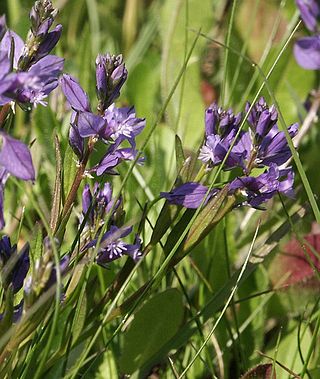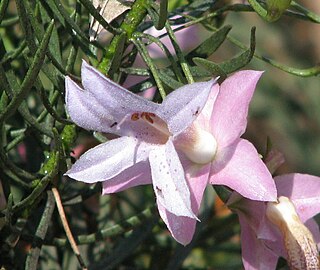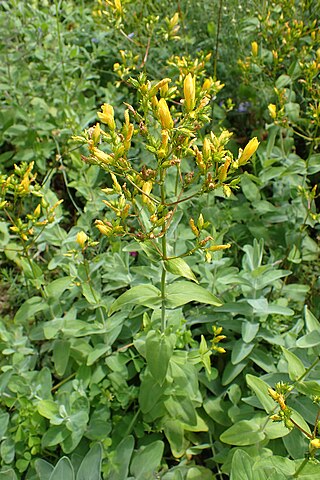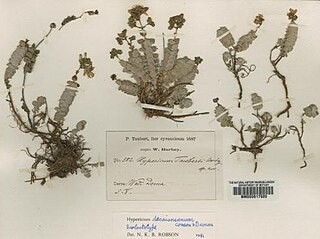
The peony or paeony is any flowering plant in the genus Paeonia, the only genus in the family Paeoniaceae. Peonies are native to Asia, Europe, and Western North America. Scientists differ on the number of species that can be distinguished, ranging from 25 to 40, although the current consensus describes 33 known species. The relationships between the species need to be further clarified.

Cyclamen is a genus of 23 species of perennial flowering plants in the family Primulaceae. In English, it is known by the common names sowbread or swinebread. Cyclamen species are native to Europe and the Mediterranean Basin east to the Caucasus and Iran, with one species in Somalia. They grow from tubers and are valued for their flowers with upswept petals and variably patterned leaves.

Polygala vulgaris, known as the common milkwort, is a herbaceous perennial plant of the genus Polygala in the family Polygalaceae.

Antirrhinum majus, the common snapdragon, is a species of flowering plant belonging to the genus Antirrhinum. The plant was placed in the family Plantaginaceae following a revision of its prior classical family, Scrophulariaceae.

Echinocereus reichenbachii is a perennial plant and shrub in the cactus family. The species is native to the Chihuahuan Desert and parts of northern Mexico and the southern United States, where they grow at elevations up to 1,500 meters (4,900 ft). This cactus earned the Royal Horticultural Society's Award of Garden Merit.

Eremophila abietina, also known as spotted poverty bush, is a plant in the figwort family, Scrophulariaceae and is endemic to a few arid areas of Western Australia. It is a stiff, upright, compact and very sticky shrub with distinctive, dark bluish-green leaves and pale coloured flowers spotted purple.
This glossary of botanical terms is a list of definitions of terms and concepts relevant to botany and plants in general. Terms of plant morphology are included here as well as at the more specific Glossary of plant morphology and Glossary of leaf morphology. For other related terms, see Glossary of phytopathology, Glossary of lichen terms, and List of Latin and Greek words commonly used in systematic names.

Kennedia coccinea, commonly known as coral vine, is a species of flowering plant in the family Fabaceae and is endemic to the south-west of Western Australia. It is a twining, climbing or prostrate shrub with trifoliate leaves and orange-pink, red and pink, pea-like flowers.

Polanisia dodecandra is a species of flowering plant in the Cleomaceae family, known by the common name redwhisker clammyweed or clammyweed, and there are three subspecies of Polanisia. Usually annual, occasionally perennial, Polanisia is native to North America, and is found throughout much of Canada and the United States. It favors full sun, mesic to dry conditions, and barren, sandy or gravelly soils, even highly disturbed areas where there is little other ground vegetation. It looks similar to a close relative, the spider flower (Cleome).

Angophora bakeri, commonly known as the narrow-leaved apple, is a species of tree that is endemic to New South Wales. It has rough, fibrous bark on the trunk and branches, lance-shaped adult leaves, flower buds in groups of three or seven, white or creamy white flowers and oval to cylindrical fruit.
Iris dolichosiphon is a plant species in the genus Iris, it is also in the subgenus Iris and in the section Pseudoregelia. It is a rhizomatous perennial, from China and Bhutan. It has long, thin dark green leaves, very short stem, and dark blue, purple, or violet flowers. That are mottled with white. It has thick white/orange beards. It has one subspecies, Iris dolichosiphon subsp. orientalis, from China, India and Burma. It has similar flowers. They are cultivated as ornamental plants in temperate regions

Hypericum aegypticum is a species of flowering plant of the St. John's wort family (Hypericaceae) which is native to the Eastern Mediterranean. It was described by Carl Linnaeus in the second volume of his Species Plantarum in 1753, who named it after Egypt despite it not being distributed there. The plant is commonly known as shrubby St. John's wort or Egyptian St. John's wort in English. Like other members of section Adenotrias, it is found among limestone rocks in coastal areas. While it has been evaluated as threatened on the island of Malta, the species has no legal protections.

Hypericum annulatum is a species of flowering plant in the family Hypericaceae. It is a perennial herb of varying heights which grows upright, with more than a hundred flowers of a golden yellow color. First described in 1827, the species has a wide distribution from Eastern Europe to East Africa, and its appearance can vary greatly based on its geographic location. It has been used in Bulgarian folk medicine, and has more recently been investigated for its effectiveness in slowing the growth of or killing certain types of human cancer.

Acacia capillaris is a shrub belonging to the genus Acacia and the subgenus Lycopodiifoliae that is endemic to small area in north western Australia.
Iris cedreti is a species of flowering plant in the genus Iris; it is also in the subgenus of Iris. It is a rhizomatous perennial endemic to Lebanon. It has long narrow leaves, short stem, and flowers with a white background which is covered with very small dots or veins of dark maroon, purple, purplish-maroon, or almost black. It has a dark maroon signal patch with a brownish or purplish beard. It is rarely cultivated as an ornamental plant in temperate regions, as it needs very dry conditions during the summer. It is listed as critically endangered by the IUCN.

Vexatorella obtusata is an evergreen shrub, with narrow, leathery leaves and about 2 cm big, globular flowerheads consisting of well scented, creamy pink flowers, from which a long style with a thickened tip extends. Two subspecies are distinguished, both restricted to different parts of the Western Cape province of South Africa. The creeping V. obtusata subsp. obtusata, also known as the Montagu vexator flowers from September to December, and the upright V. obtusata subsp. albomontana, also known as the Witteberg vexator, that has flowers between August and November.

Hypericum heterophyllum is a flowering plant in the Hypericaceae family and is the only species in Hypericum sect. Heterophylla.

Hypericum decaisneanum is a species of flowering plant in the St John's wort family Hypericaceae. Named for French botanist Joseph Decaisne, it is a small perennial herb that grows mostly upright. It has thick, papery leaves and up to twenty flowers with bright yellow petals. Endemic to the Jebel al Akhdar province of Libya, H. decaisneanum is found in the cracks of limestone rocks on steep escarpments. It is a member of numerous plant communities and associations of chasmophytes, of which it is sometimes a key species. First described in 1899, the species was originally placed in section Taeniocarpium of the genus Hypericum, but conflicting relationships have meant it has been treated more recently as a member of section Adenosepalum.

Glaucium secmenii is a species of flowering plant in the horned poppy genus which is endemic to Turkey.

Glaucium grandiflorum, the great-flowered horned poppy, is a species of flowering plant in the horned poppy genus which is native to the Middle East.
















